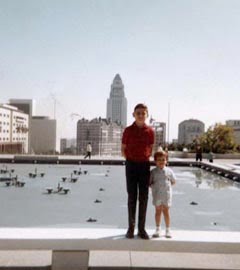
From my family photo album, The Los Angeles Skyline - 1970. From L to R, The Pacbell Tower, est. 1961, The 611 Building, est 1967, my cousin Gio, est. 1950 and The Union Bank Plaza, est. 1968.
 The Los Angeles Skyline as seen from The Pershing Square Ice Skating Rink - January 2011. The PacBell Tower does not look as lonely today as it did in 1970. Photo on black and white film by El Niño Angeleno
The Los Angeles Skyline as seen from The Pershing Square Ice Skating Rink - January 2011. The PacBell Tower does not look as lonely today as it did in 1970. Photo on black and white film by El Niño AngelenoCompared to its big brothers on the East Coast, Los Angeles is but a teenager, barely sprouting its skinny legs in the roomy interior of an old Pontiac sedan and learning how to drive shortly after the end of WWII. Downtown Los Angeles has gone through a bit of a face lift over the last 50 years or so. Change that brought street level parking lot madness in the 1950s and that transformed Bunker Hill from Victorian homes to steel skyscrapers in the 1960s, change that brought a unique post-modern building called The Bonaventure in the 1970’s and that brought urban blight in the 1980s, change that finally brought a subway system in the 1990s and that brought a series of revitalization projects in the 2000s. The US Bank Tower, The Staples Center, LA Live, The Nokia Theatre, The Disney Concert Hall and The Cathedral of Our Lady of The Angels are among the many projects that have sprouted up in the last 20 years. I must have blinked for a moment in the late 1980s as I got on the 110 freeway North at 4th Street and a short moment later glanced back in the rear view mirror, only to see all of these projects completed and in full swing. I must have been stuck in traffic longer than I thought.
The Los Angeles skyline is still growing thicker and fuller like a rockabilly pompadour reaching for the sky. The arteries of its public transportation rail system continue to expand every year, hopefully some day reaching every corner of the region including the big beautiful blue eyes of the Pacific Ocean. (Hey, I had to take a 2 hour bus ride from Silver Lake to Santa Monica when I was a teenager.) The result of an adaptive reuse ordinance set forth in 1999, many of the old historic buildings that sat vacant for decades were converted over to residential lofts, thus bringing back the urban dwellers that left downtown and surrounding neighborhoods decades ago as part of suburban flight.
I don’t claim to know everything about Los Angeles, in fact I know very little. I can’t recall the exact moment in 1966 as a three year old Angeleno that I stood with my older brother at the DWP building to pose for a family snapshot (the cover photo of this blog). City Hall is showcased in the background of that photo and that 1928 icon is just like another member of the family looking for face-time in the family photo album. My earliest memory of Downtown Los Angeles is simple yet beautiful; riding The Angels Flight Railroad in my father’s arms shortly before it closed in 1969. Angels Flight returned last year and Downtown Los Angeles continues to amaze me. (For a great look at Downtown Los Angeles and Bunker Hill check out Ken MacKenzie’s 1961 film, The Exiles.)
Build it and they will come. Population in the City of Los Angeles:
Year Census Population
1910 319,198
1920 576,673
1930 1,238,048
1940 1,504,277
1950 1,970,358
1960 2,479,015
1970 2,811,801
1980 2,968,579
1990 3,485,398
2000 3,694,820
2010 3,792,621

No comments:
Post a Comment